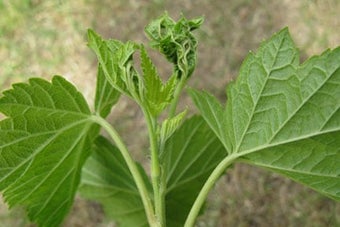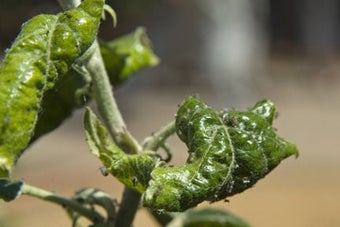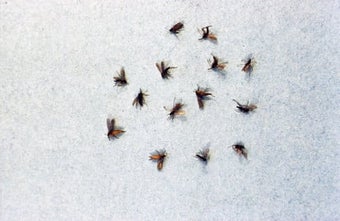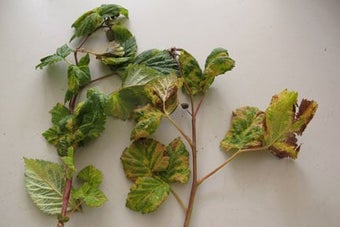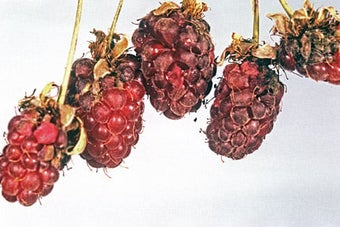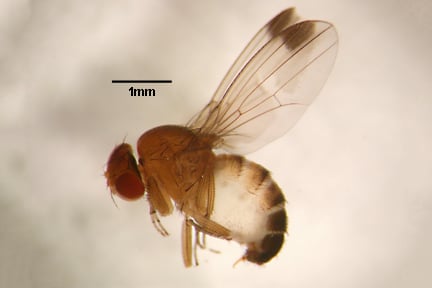
Quick facts
Common name - Spotted wing drosophila (SWD)
Scientific name - Drosophila suzukii
Plants affected - A wide range of soft, stone and ornamental fruit
Main symptoms - Collapsing fruit or fruit with small puncture holes
Caused by - Larvae of a small fly the Spotted wing drosophila
Timing - Damage seen in summer and autumn
What is spotted wing drosophila?
Drosophilidae is a family of true flies known as the vinegar fly, although they are often referred to as fruit flies (this refers to another family of flies the Tephritidae). Many drosophila feed on decomposing organic matter particularly fruit and at least six species can be found in homes around fruit.
Spotted wing drosophila (SWD) is similar in appearance to several species of vinegar fly in Britain, but differs in that the adult males have a distinctive spot on each wing and the adult female has a saw-like egg laying organ (ovipositer), which is used to pierce the skin of developing fruits. The female lays eggs under the surface of the skin, which turn into small white larvae (4 mm in length), which damage the fruits.
Further information on identification can be found on the AHDB Horticulture website. Unlike vinegar flies SWD can damage nearly ripe and ripe, unblemished fruit. A native of south-east Asia, SWD is now widespread throughout much of the major fruit growing areas of the world.
Symptoms
SWD targets developing fruit, causing damage and resulting in deterioration. Damage from the fly is most likely to be found during warm and humid weather.
SWD can affect a wide range of fruits including raspberry, blackberry and berries, strawberries, currants, blueberries, gooseberries, grapes, cherries, plums and also peaches, figs, apricots and nectarines. It may also occasionally affect apricots, elderberries, nectarines and tomatoes. Some wild plants such as blackberries and sloes are also vulnerable. Sloe fruits persist for much of the winter and so can support SWD populations during this time.
Fruits and berries on ornamental plants such as Sorbus can also be affected.
Management
SWD can be difficult to control unless prompt measures are taken. Good crop hygiene and trapping can give some protection, combined with covering crops by using fine (less than 0.98 mm) insect proof mesh.
Trapping and monitoring is the best way to prevent damage to fruit. A specially formulated pheromone trap is available from suppliers such as Agralan and Andermatt. Other traps and lures are available from some other suppliers or similar traps can be made at home. More information on trapping including demonstration videos are available from the AHDB. Grouping two or three traps together can give better results. In cherries, plums, currants, blueberries, raspberries, blackberries and other berries, it is best to put the traps on the shaded side of the plants.
In gardens or allotments that border wilder areas, copses or woods, place the traps in the fence or border line first as these will catch any SWD living in the natural habitat before they can reach the garden fruit plants. In small fruit plots using several of these traps for monitoring can help to attract adults away from fruits.
When checking traps to see if any SWD have been caught, it is can help to pour the liquid contents through a sieve over the kitchen sink. The contents of the sieve can then be gently sprayed with water using a hand held plant mister to remove the lure. Allow the insects trapped in the sieve to dry before shaking them over a white tray or card to examine them. A hand lens or magnifying glass can greatly ease the task of checking for the distinctive black spots on the wings of the male flies.
If SWD adults are found in the traps, you can exclude them from fruit by using very fine mesh netting (less than 0.98 mm), to protect the plants from the adults.
Keep trapping and monitoring until the end of November even if crops have finished to reduce populations for next season.
SWD has been found to overwinter in wild and wooded areas, so if possible such areas in the vicinity of a garden should be monitored through the winter and spring months. This will indicate if SWD is present near a garden and highlight the need for further monitoring and control measures from spring onwards.
Crop hygiene. In addition to monitoring and trapping, ensuring good levels of crop hygiene are maintained in and around fruit plants can help to avoid attracting SWD. Pick fruit when it is ripe and don’t allow old, damaged or diseased fruits to remain on the plants or lie on the ground. Remove overripe fruits and all waste and dispose of responsibly.
Do not dispose of fruit on a heap as this could attract more SWD. Compost heaps can provide a perfect breeding site for SWD which will only further increase the size of the population in and around a garden. Dispose of fruit in rubble sacks, readily available from hardware stores. These need to be sealed to prevent adults from escaping and if left in the full sun for several days, the adults will be killed by the high temperatures experienced inside.
Barriers can be installed pnce fruit has set; covering fruit with netting can exclude the adult flies and reduce crop damage. These can be made at home or premade sleeves are available from Agralan.

